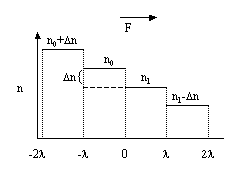|
F = |
(A-1) |
The slope of the upper atomic population may be derived by first starting with equations (5) and (6) and looking at just the central zone. The flux, F, is defined as usual,
Setting all derivatives with respect to time to zero and integrating the transport equation (5) over angle and frequency and then adding it to equation (6) gives
Since this problem is symmetric, we can integrate this equation over the right half the central zone of width, Lexc, giving
whereIn order to get an analytical solution outside the pumped region, we notice that the flux is constant there and it is given by equation (A-3). Guided by the diffusion approximation, we now assume that that the radiation field is given by the form
where B(x) is an isotropic Planckian distribution, and the second term is a P1 distribution.The flux can be found from equation (A-1),
which shows that g is not a function of space. We also note that the line profile,The difficulity in setting up a problem lies in knowing how fine the mesh must be to reduce teleportation error. For this problem, we can define a parameter to represent the optical depth per zone as given in the following equation:
where
Figure B-1:
Zoning Diagram for Milne's Problem
This problem has been discretized into equal sized zones with the assumption
that the upper atomic population, n, is constant across a zone. Since
we have focused on the right side, n can be represented by a step function
with steps at each multiple of ![]() as shown in Fig. B-1.
In this figure,
as shown in Fig. B-1.
In this figure, ![]() n is equal to n0 - n1.
We are interested in computing F at the midpoint in terms of
n is equal to n0 - n1.
We are interested in computing F at the midpoint in terms of ![]() and then relate this to the slope of the upper atomic population.
Since we wish to study the effects of small optical depth per zone length, we
assume
and then relate this to the slope of the upper atomic population.
Since we wish to study the effects of small optical depth per zone length, we
assume ![]() is much less than one. Doing so allows us to approximate the
angle integrated photon density distribution by integrating the emission in
each zone and differencing the flux from the right and left as
is much less than one. Doing so allows us to approximate the
angle integrated photon density distribution by integrating the emission in
each zone and differencing the flux from the right and left as
The bracketed terms in equation (B-2) can be summed to get the following solution for F: